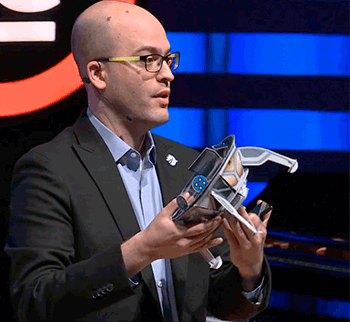Next on Israel’s agenda: the moon.
An Israeli team hopes to land a small, relatively cheap spacecraft on the moon in 2018, a first for a country already acclaimed for its space and satellite programs.
Designed and built by SpaceIL, an Israeli company founded by three young engineers in 2010, the four-legged craft answers a challenge from Google Lunar XPRIZE, a call to engineers, entrepreneurs and innovators from around the world to develop low-cost methods of robotic space exploration.
To succeed, a privately funded team must build a craft that successfully lands on the lunar surface, can travel 500 metres and can transmit high-definition images and video back to Earth.
First prize is US$20 million ($26.5 million). Second and “bonus” prizes are US$5 million each.
READ: YOUR DAILY SPIEL FOR MONDAY, JULY 17
If the Israeli project wins, the money will go toward promoting science education for young people, promised Yonatan Winetraub, one of the founders of SpaceIL, in a recent talk at ideacity, media mogul Moses Znaimer’s annual three-day festival of speakers from the fields of science, the arts, activism and academia.
To date, SpaceIL’s programs promoting education and scientific exploration have reached over 300,000 children in Israel. Winetraub’s advice to kids is, “find the moonshot within you.”
Israel’s entry is a squat, crab-like contraption that’s 1.5 metres tall and 2.1 metres wide, and weighs just 559 kilograms when fully loaded with fuel.

Winetraub, currently a PhD candidate at Stanford University who’s working on a method of intercepting and interpreting cancer cell communications, took the audience through the mechanics of landing the craft on the moon.
Rockets will take the probe out of the Earth’s orbit and propel it the 380,000 kilometres to the moon. “Then comes the most difficult part of the mission,” Winetraub explained, “and that is the landing.”
Because the craft will be travelling at two kilometres per second – faster than a bullet – and because there’s no atmosphere on the moon, parachutes and airbags will not work, Winetraub said.
“Our only hope is to use the main engine of the spacecraft and brake as hard as we can to bring it down to a safe landing to altitude zero. Not kind of zero. Zero,” he said.
Adding to the challenge is that signals take a few seconds to go back and forth between the Earth and the spacecraft, so the craft needs to be “taught” to do things on its own, Winetraub noted. And there’s very little that can be simulated on Earth, he said.
While the other teams developed large rovers to move the required 500 metres on the moon’s surface, SpaceIL developed the concept of a “space hop”: once on the moon, the craft will take off again and land 500 metres away.
Landing anything on the moon is a feat only the United States, Russia and China have managed so far.
Rather than pay for an expensive launch, the Israelis plan to hitch a cheaper ride on a rocket launching a commercial satellite.
The winner, Winetraub told The CJN, will be announced “once the first team will place their rocketship on the moon.”
In his talk, Winetraub joked that the Google competition had been open for five years and that his team’s design for the craft was submitted on Dec. 31, 2010, at 10:14 p.m. – “a solid one hour and 46 minutes before the deadline.”
But this past January, the Israelis became among five of the 33 teams that entered to get to the competition’s finals.







